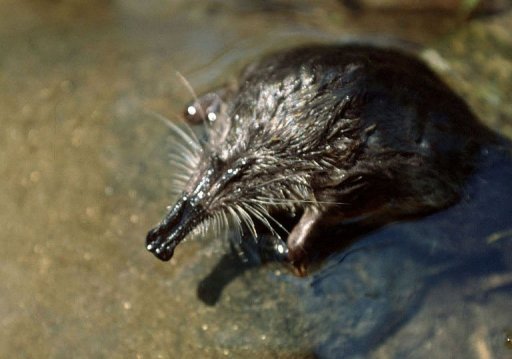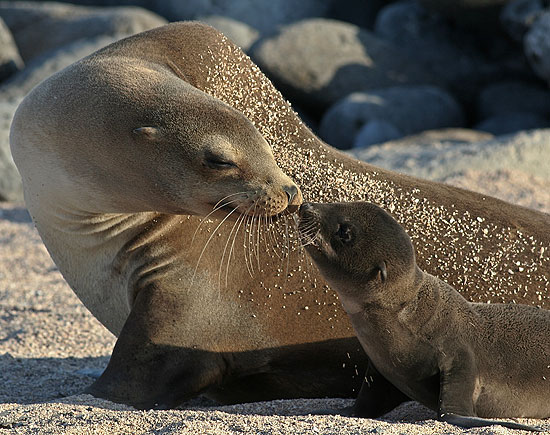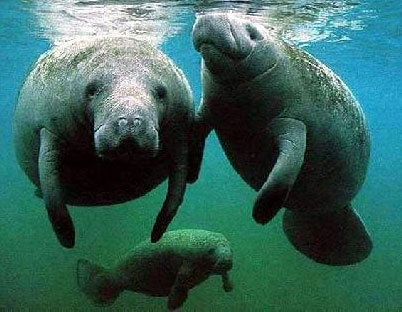
David Attenborough’s – Life of Mammals 7 Return to the Water
(Full video at the bottom)
Well what do you know. Davids riding an elephant at the beach. Seems like elephants used to do that more than often which is how their trunk evolved as a snorkel. Swim Dumbo, swim!

Shot of something called the desman … looks like a shrew but has special underwater gear… long dense fur to keep it warm in the water and a snorkel which also acts as a sensitive probe to search for snacks. Hehehe only problem dude has is buoyancy so he doesn’t stay underwater too long and has to come back to land to eat its catch.

Over to the oceans/seas. Weasel like creatures were the otters ancestors so they were more land lovers than water waders. Which is why otters hooked their feet up with webbing. Funny shot of otter floating around belly up with a stone on its stomach. Why? Because he uses it as an anvil to crack clams and shells. River otters usually mate on land but these ones got the knack for some synchronized swimming. These ones done even go back to land to sleep! Cute shot of one turning around in the water. What it’s doing is wrapping itself around some kelp so that the current doesn’t sweep it away. Amazing fact: Sea otters have more hair on one square centimeter of their body than any human ever has on their head! It’s the densest fur in the whole animal kingdom. Another cute shot of the sea otters blowing into their fur and playing with it… they do this to trap air in their fur to keep it even warmer. Poor things were hunted to near extinction because of that fur till hunting was banned.

Sealions are next. Their legs are more adapted to swimming. Front ones became paddles, back became flippers. Even though their legs evolved… they can still walk on land… in a funny way. Fur is not their only insulation. They got a layer of fat… BLUBBER. What a wicked name… blubber. What differenciates a sea lion from a seal is the sea lion has external ears. They give birth on land… and how tasty do the babies look… hmmm sausages with wings. They cant find safe coves to caves to give birth in so all the babies are gathered on open land that David calls a patch. Each patch is dominated by a big male/beach master who will claim any female who lands on his patch and mate with her as soon as she’s given birth. Hehehe he also keeps a sharp look out for any other male that has the same idea… shot of beach master representing! Now mom’s gotta get back in the water so she feeds the babies at high speed with 30% fat in the milk. So the baby converts that into blubber. After 3 months mom’s takes baby for a swim. Hard work because there’s entangling beds of kelp.

We’re in South of New Zealand now… the Antarctic. It’s so called the sea freezes over. David says seals and sea lions seem to be descended from an early carnivore, something like a mix of weasel and bear. Seals did a better job evolving for water. Another differenciation from seal lions is their legs… seals cant use them to walk. So they gotta hump its whole body or slide around to get by on land. Lucky for moms, here they can give birth without dangers/terrestrial hunters. Crazy shot of pup being born… lets just say it tried to fit its whole body in a huge condom and it bust at the end.

What? Suddenly we’re in the Arctic. Hmmm David wants to show us some land predators. All I see is footprints of an arctic fox. David traces it till foxes den. And with a scary tool starts sawing around the den. Kinda like what you see in cartoons. Ok, so the seal burrowed from the sea and made this little … burrow? And the fox somehow guessed it so dug to it from land. Cant see blood so I guess the pup got away safely. But there’s bigger dangers out there!

Polar bears on the look out for pups. Something called ringed seals? Ringed seal pups cant swim for several weeks so their survival depends on them remaining undetected under the snow. Adults are safer being able to stay underwater for 20minutes plus. But they have to get back to their breeding holes or they’ll freeze over. Amazing fact: Polar bears sense of smell is so good they can detect the breath of a seal drifting over the snow over half a mile away. Polar bear pounces on a den (which could have killed the pup outright). But this one was already dead, stiff and frozen. David talks about different seals having different mating and breeding styles.
Amazon #ads
Gaad damn! Hooded seals are crazy man! First of all they wait around females waiting for them to ‘get in the mood’. Second they have some freaky noses/lips which blow up like balloons. So it inflates the hood on the head so much it comes out of one of its nostrils. Now if literally blowing their noses doesn’t chill out a tense situation, they gotta get gangta! I’m glad that’s over.
Male harbor seals have a different courtship ritual. The mechanisms of which are still not fully understood because it was discovered quite recently. Competitive choral singing. One dude begins it, drifting underwater upside down. Others join in, holding their heads together like a barbershop group. Sounds like something you’d hear males doing after a family dinner. Hehehe. Anyway so when a female appears the one who started singing leaves with her while the rest follow obligingly.

Now for some vegetarian swimmers. Davids belly deep at a florida beach with 3 manatee or sea cows (extra large walrus kinda things). Hehehe David jokes about their extra strong halitosis. No one knows their ancestors, some say elephants because of the teeth. Interesting fact: Their teeth are flat grinding molars, which after being worn down are replaced by new ones that erupt at the back of the jaw and slowly move forward. They’re so big they are hardly ever attacked and there’s more than enough vegetation they don’t need to be swift swimmers. Front flippers have nails… just like that and a huge flat powerful tail.
Over to the Ganges in India. There are water living mammals here but difficult to spot especially coz its very cloudy and full of sediment. Ah, a river dolphin. Because you cant see in the waters, the dolphins here have lost the use of sight. They use sound/sonar. David lowers an underwater microphone to hear what sounds they make. Sounds like static or electric belching. By the way the dolphins look like they have some extra long nose.
Suddenly we’re in the US, Carolina and Georgia. Here the dolphins way of feeding is daring and complicated. But the birds know how to predict it. Why the birds? Well see these dolphins first edge around the shore… in a way pushing the little fish close. Then there’s one swift attach where all the dolphins push the fish to the shore. So the dolphins get to snap them up on land, but so do the birds. Dolphins wiggle back to water and look for another place to do it again. Clever birds give David a clue where the next ones going to be. Communication and syncronization is paramount. Also when they do attach together the have to all face the same direction… as in when they’re getting their bite on land if 2 face another direction they either have to fight for the fish if they face each other or have to miss out if they face away from each other.
Out in the ocean dolphins may number several hundred. Amazing shot of common dolphin stitching through the waters while the birds follow them in air. The whole school of dolphins span about a quarter of a mile on either direction of David’s boat. Wow the dolphins chase and herd a huge school of sardines, turning them into one big meatball. The dolphins drive them upward so its trapped against the surface. Which gives the sea birds an opportunity too. And boy do those sea birds dive for it.

David talks about an animal that does not use teeth. Instead it uses something called baleen. This stuff is horny plates with long coarse hairs which collects krill. Krill are shrimp like creatures that are no bigger than your little finger. This mammal finds them in such quantity that its becomes gigantic. Wicked animation of the animals skeleton slowly showing the real baleen and tongue. Now it takes in huge amounts of water with the krill and with its tongue the size of an elephant wipes the krill from the baleen. Aparantly this mammal is twice as heavy as the biggest known dinosaur… who ‘knows’ a dinosaur? More animation revealing the ribcage and stuff. Their lungs carry 2000 litres of air (500 times the capacity of our lungs). The heart is as big as a small family car and beats only 5-6 times a minute but drives 10tons of blood through a million miles of blood vessels. More animation. All that is left of any sign of legs are a couple of bones buried in a mountain of muscle. THE BLUE WHALE. It’s a hundred feet long (30 meters). Nothing on land can grow that big because the bone is not that strong. Apparently the blue whales ancestors were land living deer like creatures that lived 55 million years ago. Paras note: You know my rule… find out for yourself! Get this… the whale refreshes 90% of its air while humans void only 15%. Paras note again: Art of living folks refresh the same as whales :oP. Anyway so it can store oxygen not only in its blood but also in the tissues of its vast body. It can stay underwater for half and hour plus. With one gulp it takes in a ton of krill filled water. Some parts of its body is coated with blubber nearly 20 inches thick. A perfect hydrodynamic body uninterrupted by ears limbs or genitals. Communicate through sound. Humpback whales have deep notes almost beyond our hearing range. If you swim beside them, the notes will have an effect on your body like that of an organ inside a cathedral. The more complex notes are directed to females as an invitation to mate. Each area code of whales sing the same kinda choons. Each song lasts half an hour, then the male may repeat it, maybe for several days.
Ardent males try to get it on with a female but ‘she’s not in the mood’. So whales get that too hahahaha. Since she’s not up for it she just turns upside on the surface to keep her bits away from theirs. Uh-oh… doesn’t seem to be working for her this time… a slit opened up in the male, 12 feet long penis is ready and highly mobile. Mobile indeed, its like those tentacle things you see in action movies that creep up and grab your legs and hands. The males barge and jostle and several may succeed one after another. She’s changed her mind and decides she’s ready so goes back underwater ready for a male. Male right whale have gangsta testis, weighing up to a ton which produce gallons of sperm. Paras note: Something to remember when you’re at the beach. One coupling can flush out whatever preceeded it so it may not be the first one that’s the father. It will be the last.
1. A Winning Design | 2. Insect Hunters | 3. Plant Predators
4. Chisellers | 5. Meat Eaters | 6. The Opportunists
7. Return to the Water | 8. Life in the Trees | 9. The Social Climbers
10. Food for Thought





